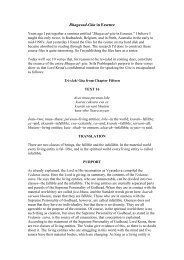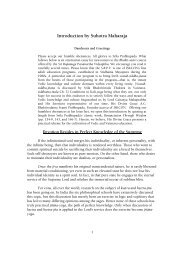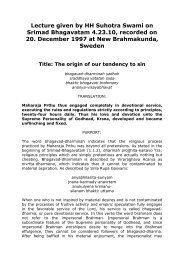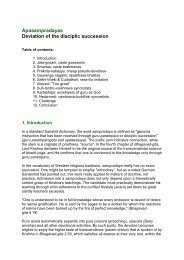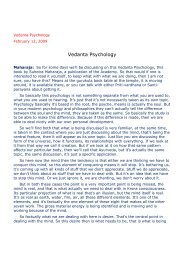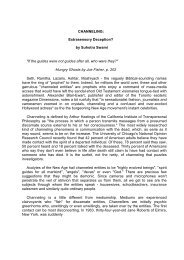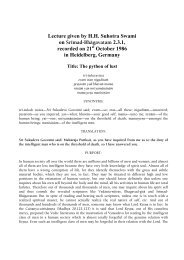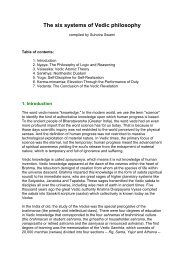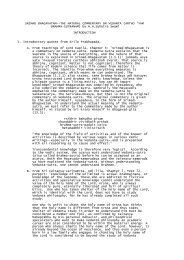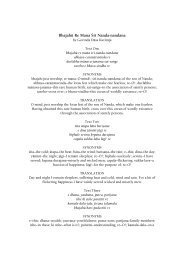What The Upanisads Teach.pdf - Suhotra Maharaja Archives
What The Upanisads Teach.pdf - Suhotra Maharaja Archives
What The Upanisads Teach.pdf - Suhotra Maharaja Archives
Create successful ePaper yourself
Turn your PDF publications into a flip-book with our unique Google optimized e-Paper software.
<strong>What</strong> the <strong>Upanisads</strong> <strong>Teach</strong>Part FiveBrahman is Isvara, the Supreme ControllerThroughout the <strong>Upanisads</strong> we find names like Isa, Isvara, Isana, Sarvesvara,Mahesvara and Vaisvanara. All confirm that Brahman is the supreme controller. <strong>The</strong>texts in which these names appear do not assign them to Saguna Brahman only, asopposed to Nirguna Brahman. It is the theory of the impersonalists that Isvara is notBrahman per se but rather a personification of the highest grade of the materialmode of goodness. That is Saguna Brahman; but the real Brahman is nirguna, so theMayavadis say, and it is completely disassociated from the affairs of the universe.But Brhadaranyaka Upanisad, which is supposed to be the most monistic Upanisad ofall, declares atma (the Supreme Soul) to be sarvesam bhutanam adhipatih (the rulerof all beings) and sarvesam bhutanam raja (the king of all beings). (Br. U. II. 5. 15)In IV. 4. 22 of the same upanisad we find Brahman to be the controller of all(sarvasya vasi), the ruler of all (sarvasya isanah) and the Lord of all (sarvasyaadhipatih).A section of Chandogya Upanisad is dedicated to vaisvanara-vidya. In it the sageAsvapati Kaikeya instructs five householder sages on how to properly meditate uponVaisvanara. And what is Vaisvanara? Srila Vyasadeva makes that clear in sutra 1. 2.25 of the Vedanta: vaisvanarah sadharana sabda visesat--"<strong>The</strong> word vaisvanaradenotes Brahman because of its special properties. " <strong>The</strong>refore Vaisnavara cannotpossibly refer to the jiva. Chandogya V. 18 explains that the word is derived fromvisvanara, which means "He who is the ruler of all human beings" (visvesamnaranam netara) and "He who is the soul of all" (visvesam ayam narah). <strong>The</strong>conclusion is inescapable: Brahman is directly Isvara. <strong>The</strong> theory that Isvara is onlythe topmost evolute of matter is not supported by the <strong>Upanisads</strong>.Svetasvatara Upanisad is most explicit in this regard: sarvasya prabhu isana; vasisarvasya lokasya sthavarasya carasya ca: "Brahman is the Lord and ruler;" "He isthe controller of all the moving and non-moving entities in the world. " (Svet. U III.17, 18) Other verses of this Upanisad declare isvaranam paramam mahesvaram, "Heis the Lord of lords;" devatanam paramam daivatam, "He is God among thedemigods;" patinam paramam patim, "He is the Leader of leaders;" na tasya kascitpatirasti loke no ca isita, "No one within the universe is master to Him, nor doesanyone rule over Him. "Brahman is Purusa, the Personality of GodheadIn Sanskrit, purusa means "one who dwells in the body. " Thus it is applied to bothsoul and Supersoul. When the <strong>Upanisads</strong> employ this word as an appellation ofBrahman, the meaning is that the Supreme is a person and His body istranscendental.Brhadaranyaka, favorite Upanisad of the Mayavadis, states atmaiva idam agra asitpurusavidhah--"Before creation there was only Brahman in the form of a person. "(Br. U. I. 4. 1) Brahmana 3 of adhyaya II of Brhadaranyaka is known as Murta-Amurta Brahmana; here two appearances of Brahman are discussed. Murta meanscorporeal and temporary and amurta means incorporeal and eternal. Verses II. 3. 5-6 constitute a description of the amurta Brahman. He is called purusa, a person. This7



